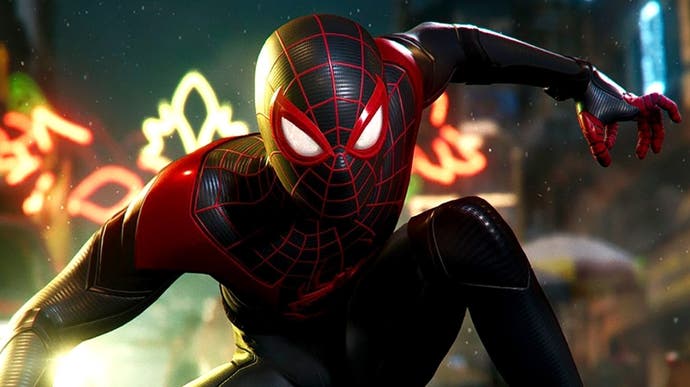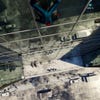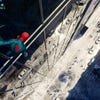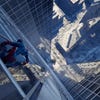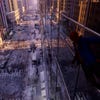Marvel's Spider-Man: Miles Morales is the perfect kick-off for the next generation
From ray tracing to performance mode, Insomniac and PS5 blow us away.
Released in 2018, Marvel's Spider-Man stands as one of the most impressive games of the PlayStation 4 generation. With a huge, detailed environment, gloriously detailed characters and top-tier post processing effects, in combination with superb, well-balanced gameplay, Insomniac demonstrated once again why it's one of the most talented, ambitious studios around. And somehow, with Marvel's Spider-Man: Miles Morales, the developer not only has to top it, but to provide a next-generation vision for PlayStation 5, while at the same time also delivering a PlayStation 4 rendition of the game. The odds seem insurmountable - but rest assured, Miles Morales delivers.
It begins with the simple act of launching the game. Once you clear menu screen animations, loading times are a mere four seconds - an astonishingly short space of time. In fact, the UI transition adds three seconds further to the count. This is so fast that it rivals any cartridge-based system from the past. We've had optical discs and spinning platter drives limiting the speed of consoles for more than two decades, but with the arrival of a fast SSD in the PS5, we're witnessing the end of waiting - or at least, that's the hope, and Spider-Man: Miles Morales highlights what's possible. By comparison, the original PS4 Spider-Man took over 30 seconds to load.
It's not just the fact that SSD technology has been added to the mix, though - the new hardware decompression blocks integrated into PS5's SoC also free up valuable CPU time, aiding performance elsewhere. So what we're looking at here is a combination of super-fast storage and decompression in conjunction with Insomniac's own streaming technology that helps make these remarkable loading times possible. And once the game has completed its initial load, the first glimpse of Miles himself reveals further next-gen enhancements. The level of detail on the character is certainly eye catching, but what's new?
The first thing that really stands out to me is the new hair strand system, which extends to all of the characters in the game. Not only is this system flexible enough to handle different types of hair, but each representation is of exceedingly high quality. The way light plays off the hair strands, the way it moves as characters emote - it's a nice upgrade from the previous game. Sub-surface scattering is also increased in quality, leading to more realistic depiction of skin translucency, while eyes and teeth are now more detailed with additional screen-space shadows bringing finer close proximity detail. Character rendering was already top-notch in the original Marvel's Spider-Man, but these changes really enhance the overall presentation. The in-game model is similarly detailed. Thanks to photo mode, it's possible to bring the camera right up against each character. The resolution of the materials is absurdly high, while facial details are just exceptional. The PS4 game still looks good but elements like eyebrows, hair, skin and eyes receive a massive boost in fidelity for the new game.
However, it's the representation of New York City that perhaps best showcases Insomniac's technology and the capabilities of the new console. Yes, hardware-accelerated ray tracing is a big deal here, but detail across the board is improved. The draw distance of vehicles and pedestrians is pushed out significantly while the overall density is increased: this means more activity at street level, resulting in a world that feels more like a bustling metropolis. In the original game, you could very clearly see where the activity ended in terms of draw distance - and while it worked OK given the hardware limitations, head-to-head comparisons between generations are eye-opening to say the least.
The shift to winter time also has an impact on the experience - trees are now rendered differently with barren branches which wind up looking more detailed and realistic to the eye. In general, there is an increase in both geometric complexity of scenery and props alongside a boost in density - like cars and pedestrians. Even even during missions, there's simply more going on: more objects, more interaction. Overall then, the comparison is fascinating: the core of the city is very much derived from the previous game but the increased draw distance, object density and even the new season helps flesh it out. Additionally, many materials have been reworked or touched up with new, higher-resolution surfaces visible in many areas throughout the world.
Beyond all of this, the real-time ray traced reflections are simply phenomenal. This is the very first console game we've played with this feature and its arrival reveals many interesting things about the this upcoming generation - and it just so happens that Spider-Man is a perfect game to show it off. Basically, as with any modern city, the world is packed full of shiny surfaces. Glass panels adorn buildings, the metalwork of every vehicle is inherently reflective as are the many polished metals across the world. Put simply, all of these materials produce realistic reflections generated using PS5's hardware accelerated ray tracing. The primary benefit during gameplay is additional parallax and sense of depth while exploring the world. Scaling the side of a building and seeing all that detail reflected across its surface is a true sight to behold, boosting the sense of scale and adding much more realism to the overall presentation.

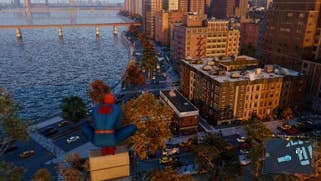



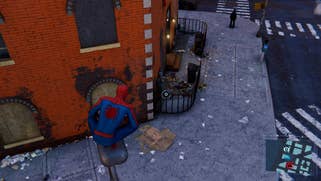
Simulating reflectivity has always been a difficult problem to solve in city-based games. Typically, games like Spider-Man on PlayStation 4 relied on a combination of cube-maps generated from probes (literally static environmental samples) along with screen-space reflections. The probe system is a good solution but has obvious limits in terms of what it can display. It's plain as day staring into a building surface adored with a simple cube-map: it can look nice enough but it's static and fails to reflect the world around you and the action taking place within it. The jump to ray tracing makes navigation feel so much better, especially while swinging. Check out the video at the top of this page: all the other places where ray tracing shows up enhance the experience, and skyscraper reflectivity in particular is simply phenomenal. At street level, let's put it this way: #puddlegate is a distant memory.
Insomniac's approach here enables stunning results. Reflections appear on both opaque and transparent geometry such as windows - so you can see your reflection, but still peer through the glass itself. The game uses stochastic ray tracing which requires more rays to be fired but produces a more accurate result. A ray will travel until it collides either with an object or when it reaches the edge of the world - that is, the sky or water - so reflections can show arbitrarily distant objects. There is no fallback using reflection probes either - everything is generated using ray tracing. Crucially, the decision was made to include shadows within the ray tracing structure, ensuring that those cast by large buildings are present in reflections. This is not always taken into account but by doing so, the depth of the city remains intact when peering into reflective surfaces. There are limitations: a lower detail version of the city is used for RT reflections. It's not especially noticeable most of the time, but it's the reason why you might pick up on a missing detail here or there. Furthermore, screen-space reflections are also blended into the RT reflections for certain objects such as window frames.
Impressively, all dynamic objects are factored into the BVH structure - main characters and vehicles have their BVH refitted every single frame while pedestrians update every other frame. This ensures that all action happening within the world appears correctly within reflections, another impressive technological feat. Naturally, the roughness cut-off is also adjusted carefully to maximise performance - what this means is that there is a threshold in which the surface of a material, such as stone, is too rough to receive reflections. Technically it's still possible to trace rays here, but their dispersal across such a material inherently makes rough reflections more demanding. In the case of Marvel's Spider-Man: Miles Morales, a good compromise has been achieved - there are, of course, near-perfect mirrors, but also rough surfaces which showcase proper reflections as well. It is worth noting that there are currently no secondary reflections - no reflections within a reflection. This is very, very expensive to render and most games seem to fall back on cube-maps to address this, but in Spider-Man, that is currently not the case, so buildings reflected within buildings lack any sort of approximation.
Regardless, as you'll see in the video and screenshot gallery, the ray tracing implementation is extremely good - astonishingly so for a launch title on a brand new console. This is exciting new technology in the console space and it's really just the beginning. Of course, RT comes with a requisite hit to performance, so what does this mean for the rest of the presentation? Well, the fidelity mode delivers a native 4K output at 30 frames per second, which is combined with Insomniac's brilliant temporal upscaling solution for a supremely crisp image. You wouldn't think this is necessary at 4K, but this combination eliminates most aliasing and there is a tangible boost in clarity across the game when compared to PlayStation 4.
Of course, there is a 60 frames per second performance mode too, and this requires that you lose RT features altogether in exchange for a 2x frame-rate upgrade. Yes, ray tracing is gone, but there are other compromises too, starting with resolution. Naturally, with a new 60fps target, the resolution is reduced. From my counts, it seems to max out just shy of native 4K while dipping to similar pixel counts as the PS4 Pro version of Spider-Man. I counted as low as 1512p but it could potentially hit 1440p as well. The thing is, it doesn't really matter, because on average, the image quality remains higher than on PS4 Pro, which already looked wonderful. It's a perfect illustration of how actual pixel counts just don't matter that much these days: the difference between quality and performance comes down to a slightly blurrier output and that's really about it. From a normal viewing distance, it's difficult to spot.
There also exists a slight difference in the strand system - it's one LOD lower than fidelity mode, reducing the amount of tessellation needed for hair rendering. It's generally very subtle, thankfully, but it is interesting to note. The depth of field also appears slightly shallower due to the reduced resolution as is often the case, but it still looks great in both cases. Everything else, though, bar perhaps world draw distance (which is difficult to spot owing to the dynamic nature of the game) is completely on par. It works exceptionally well.
Which brings us to the real reason why you'd want to use this mode - performance. In fidelity mode, the game targets 30 frames per second just like the original and to all intents and purposes, it's locked. The game hits its target and stays there. I did encounter a dip in one area, but clearly any drop at all is very rare indeed - you can expect a very consistent experience, which is actually delivering a tighter lock to 30fps than Marvel's Spider-Man on PS4 Pro. Moving on to the 60fps mode, you can expect a near-perfect lock to the target frame-rate. Whether you're traversing the city at high speed or engaging enemies in combat, performance just doesn't seem to buckle. That's not to say dips aren't possible - this is an open-world game after all - but I certainly didn't run across them during normal play.














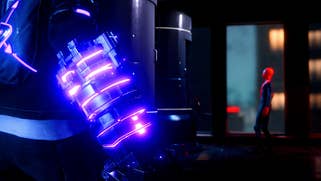
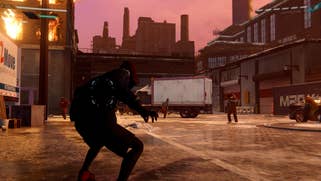

This feature more than any other really showcases what the extra power in the system can offer. We saw performance modes in many last-generation games and these generally just meant an unlocked frame-rate but highly variable performance. This is exactly what Miles Morales manages to avoid - there are no issues with frame-rate stability. Now, while gameplay is pretty much perfect, cutscenes exhibit a minor issue - basically, you get duplicate frames between camera cuts. It's honestly minor enough that it didn't typically bother me but with certain cuts, you might notice it. There are also occasional drops to frame-rate that pop-up in performance mode cutscenes that you don't see in quality mode, but still, both fidelity and performance modes are brilliant: users essentially have either a locked 30fps or locked 60fps experience here, which is better than just about any comparable modes on last-gen consoles. Which is best? It's a touch choice because I love both options. The ray traced reflections are a real game-changer and look remarkable, but that smooth 60fps is also appealing. At least both modes deliver in full.
Beyond visuals, the audio is well worth commentary too. The game takes advantage of the more advanced positional audio capabilities of the PS5 to deliver a more immersive sound experience, especially with headphones. Now, I typically prefer to play using speakers and it does sound great there too, but in general, I do feel that the audio experience is a nice step up from the original game. It seems like the sound quality is slightly higher overall and the positional audio is enhanced.
This also extends to the controller which not only uses subtle sounds in an effective manner but also takes advantage of the DualSense. Obviously, you get the haptic rumble features which are effective, but the triggers are perhaps the most enjoyable part. Basically, the tension on the trigger pulls is adjusted in a way to better simulate the act of slinging your webs... well, at least that's how I imagine it. As with Astro's Playroom, it adds a surprising amount of depth to basic actions.
As for the game itself: well, it's not necessarily a true sequel in the traditional sense so much as a game that continues where the last one left off. The key thing here is that it does feel like its own game, as opposed to glorified DLC: the new characters and atmosphere are completely different and each of the main missions is beautifully crafted, just like the original. There's also plenty of stuff to do alongside the main missions but overall, I'd say that Miles Morales is indeed more comparable to something like Uncharted: The Lost Legacy - and that's a very good thing. (You can read more in Eurogamer's Spider-Man: Miles Morales review.)
As the first full game that I've played through on PlayStation 5, Marvel's Spider-Man: Miles Morales is one heck of a place to start. It's every bit as good as the original but offers a fantastic new coat of paint alongside some cool extra features. That we have such an ambitious example of ray tracing right at launch is a really good sign for the future - things can only get better from here, and I can't wait to check out Insomniac's very own Ratchet and Clank. We'll just have to see how that turns out, but in the meantime, Miles Morales is simply a brilliant launch game and a wonderful way to kick off the next generation.
